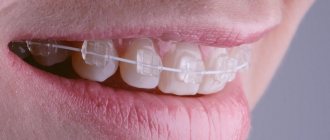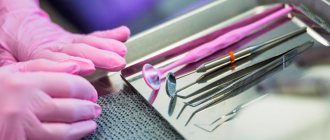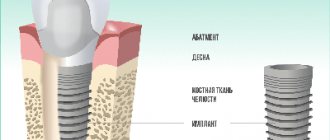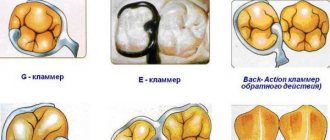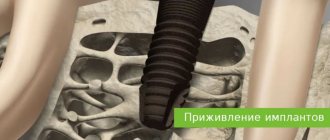When carrying out certain dental procedures, it may be necessary to reliably isolate the teeth from saliva, as well as the gums from the effects of chemicals used in treatment. For example, this is necessary when filling canals, restoring teeth and performing other complex procedures. Typically, special cotton or gauze swabs are used for these purposes. However, there is also such an alternative solution in dentistry as a rubber dam - a device that isolates the working surface from the mucous membrane during the treatment process.
Advantages and disadvantages of rubber dam
In dentistry, a rubber dam is a special rubber curtain that is installed on a tooth using clamps and isolates it from the surrounding oral cavity. This device is characterized by a whole list of indisputable advantages, among which the following are worth highlighting:
- reliable protection of the mucous membrane from the effects of chemicals;
- providing a good overview of the elements of the dentition;
- the ability to swallow during dental procedures;
- prevention of dry mouth;
- ensuring the most comfortable position of the tongue;
- eliminating the need to constantly change gauze swabs and rinse your mouth.
The use of rubber dam in dentistry significantly increases the degree of patient comfort during dental treatment. A person can breathe freely and swallow saliva, and the manifestations of the gag reflex are minimized. Patients note a decrease in fatigue of the masticatory muscles, which are usually in a tense state throughout the entire treatment process due to the need to keep the mouth open for a long time.
However, along with numerous advantages, the device in question also has a number of disadvantages, among which it is worth paying attention to:
- the possibility of developing an allergic reaction (silicone plates may be an alternative);
- possibility of injury to interdental papillae;
- the risk of losing axial landmarks when opening the entrance to the dental cavity;
- excessive requirements when conducting radiographic examinations.
If you have a problem similar to that described in this article, be sure to contact our specialists. Don't diagnose yourself!
Why you should call us now:
- We will answer all your questions in 3 minutes
- Free consultation
- The average work experience of doctors is 12 years
- Convenient location of clinics
Single contact phone number: +7
Make an appointment
Bridge insulation: superfloss
Treatment of pulpitis of the 2.1 tooth, which is the support of a bridge prosthesis
Initial situation: pulpitis of the central incisor, previously restored with a metal-ceramic crown, was diagnosed (Fig. 4 a, b).
| Rice. 4 a, b. Initial radiograph 2.1 |
The problem of placing a rubber dam on a bridge can be overcome by tying the connecting elements with superfloss.
Endodontic treatment: traversing, cleaning and shaping the root canal; filling the canal using the method of vertical condensation of hot gutta-percha; composite restoration of the palatal surface (Fig. 4 c-f).
Rice. 4c. Working Rg with gutta-percha cone in the canal
Rice. 4g. Shape of the root canal mouth
Rice. 4d. Restoration of the palatal surface
Rice. 4e. Control radiograph
Adverse reactions
Dentistry uses a rubber dam made of rubber, which can cause an allergic reaction in some patients. In some cases, the cause of a negative reaction in the body may be talc, which is sprinkled on the preparatory plates. For example, some manufacturers produce options without the use of talc. A rubber dam is a type of dental device in question that is made from silicone. This material is characterized by many advantages, but has a weaker degree of elasticity.
Before introducing this technique into your dental practice, a specialist must master the technology of applying insulating protection itself. Incorrect use of this coating, as well as an error in selecting the thickness of the rubber pads, can lead to serious injury to the interdental papillae. The use of rubber dam in dentistry during the treatment process guarantees a long service life of the restored elements of the dentition.
The dental clinic “32 Dent” carries out all types of diagnostics and treatment of diseases of the teeth and oral cavity using the latest technologies, modern equipment and the best materials. To receive advice on all questions of interest, contact us by phone listed on the company’s website.
Isolation of one tooth
Minimally invasive preparation of 2.5 teeth for an all-ceramic crown
Initial situation: inadequate and unaesthetic restoration of tooth 2.5, failed obturation of the root canals (Fig. 2 a).
Repeated endodontic treatment: installation of rubber dam, creation of access; cleaning root canals from zinc-eugenol paste; filling the root canals of 2.5 teeth using the vertical condensation technique of hot gutta-percha (Fig. 2 b-e).
Rice. 2a. initial situation
Rice. 2b. Paste in channels
Rice. 2c. Working Rg with tools in channels
Rice. 2g. Canal mouths after paste removal
Rice. 2d. Control of root canal filling of 2.5 teeth
Test with answers on the topic “Isolation of the working field: rubber dam in everyday use”
- home
- Tests
- Test with answers on the topic “Isolation of the working field: rubber dam in everyday use”
The pliers for applying clasps consist of a spring, a stopper and cheeks.
- for free
- Insulation
- use
- cofferdam
- medical
- nmo
- answers
- everyday
- fields
- worker
- topic
- Test
The pliers for applying clasps consist of a spring, a stopper and cheeks.
1. The gingival fluid is dominated by
1) B. melaninogenicus;+ 2) Str. mitis; 3) Str. mutans; 4) Str. salivarius.
2. The excretory duct of the parotid gland is located
1) on the submandibular papilla to the right and left of the frenulum of the tongue; 2) at the level of the second molar of the upper jaw from the vestibular side; 3) at the level of the first molar of the upper jaw from the vestibular side; + 4) at the level of the first molar of the upper jaw from the palatal side.
3. The excretory duct of the submandibular salivary gland is located
1) on the submandibular papilla to the right and left of the lingual frenulum; + 2) at the level of the second molar of the mandible on the lingual side; 3) at the level of the first molar of the upper jaw from the vestibular side; 4) at the level of the first molar of the upper jaw from the palatal side.
4. The excretory duct of the sublingual salivary gland is located
1) on the submandibular papilla to the right and left of the lingual frenulum; + 2) at the level of the second molar of the mandible on the lingual side; 3) at the level of the first molar of the upper jaw from the vestibular side; 4) at the level of the first molar of the upper jaw from the palatal side.
5. Gingival fluid consists of
1) desquamated epithelial cells; + 2) leukocytes; + 3) microorganisms; + 4) enzymes; + 5) erythrocytes.
6. To fix and stabilize the curtain, it is used
1) punch; 2) frame; + 3) stencil; 4) tongs.
7. The teeth of the clasp should touch the tooth at least
1) 1 point; 2) 2 points; 3) 3 points; 4) 4 points.+
8. The major salivary glands include
1) labial; 2) palatal; 3) parotid;+ 4) submandibular;+ 5) sublingual.+
9. Additional means of the rubber dam system include
1) wedges;+ 2) cord;+ 3) frame; 4) floss; + 5) tongs.
10. The tasks of isolating the working field include
1) protection of the assistant; 2) protection of the doctor; 3) protection of the patient’s respiratory tract from dust during tooth preparation;+ 4) protection of soft tissues;+ 5) protection of adjacent teeth.+
11. The minor salivary glands include
1) labial;+ 2) molar;+ 3) sublingual; 4) buccal;+ 5) lingual.+
12. Methods of isolating the working field include
1) use of cotton swabs; + 2) use of safety glasses; 3) use of composite material; 4) use of a saliva ejector;+ 5) use of tips.+
13. The main components of the rubber dam system include
1) veil;+ 2) matrix; 3) punch; + 4) frame; + 5) retraction thread.
14. What techniques can be used when applying a rubber dam?
1) “wing” technique; + 2) “curtain first” technique; + 3) “clamp first” technique; + 4) “arc” technique; + 5) “wedges” technique.
15. Clasps in the cofferdam system consists of
1) “wings”;+ 2) arcs;+ 3) vices;+ 4) festoons; 5) cheeks.
16. Clasps for which teeth have a side sign?
1) for molars of the upper jaw; + 2) for molars of the lower jaw; 3) for premolars; 4) for incisors and canines.
17. The edge of the matrix should be located relative to the formed cavity
1) 0.5-1.0 mm below the gingival wall; + 2) 1.0 mm above the gingival wall; 3) 2.0 mm below the gingival wall; 4) at the level of the gingival wall.
18. The matrix holder consists of
1) top part; 2) head part; + 3) lower part; 4) middle part;+ 5) tail part.+
19. A matrix with a notch is used for filling the vestibular surface
1) canines of the upper jaw; 2) molars of the lower jaw; + 3) premolars of the upper jaw; 4) incisors of the lower jaw.
20. The composition and number of microorganisms in the oral cavity are influenced by
1) time of day;+ 2) dental pulp diseases;+ 3) periodontal tissue diseases;+ 4) weather conditions; 5) somatic pathology.+
21. Before applying a rubber dam, it is necessary
1) familiarize the patient with the design of the rubber dam; + 2) carry out tooth whitening; 3) carry out tooth preparation; 4) remove plaque from the tooth; + 5) take diagnostic images. +
22. By what method is the curtain pre-stretched only over the frame, brought into the oral cavity, pulled over the tooth and fixed with a clamp?
1) “wing” technique; 2) “veil first” technique; + 3) “clamp first” technique; 4) “arc” technique.
23. By what method is the clamp pre-fixed on the tooth?
1) “wing” technique; 2) the “veil first” technique; 3) “clamp first” technique; + 4) “arc” technique.
24. By what method, before insertion into the oral cavity, is the curtain pulled only over the clamping arc?
1) “wing” technique; 2) the “veil first” technique; 3) “clamp first” technique; 4) “arc” technique.+
25. By what method, before being introduced into the oral cavity, is the curtain placed on the clamp arc and fixed in the frame?
1) “wing” technique; + 2) “curtain first” technique; 3) “clamp first” technique; 4) “arc” technique.
26. According to the nature of the secretion, the salivary glands are divided into
1) alveolar; 2) serous; + 3) mucous; + 4) mixed; + 5) tubular.
27. The indication for using a rubber dam is
1) the presence of fixed orthodontic appliances; 2) unstable psycho-emotional state of the patient; 3) teeth whitening; + 4) surgical intervention on soft tissues.
28. In inflammatory periodontal diseases, the amount of pathogenic microflora
1) decreases significantly; 2) does not change; 3) decreases slightly; 4) increases.+
29. In inflammatory periodontal diseases, microorganisms predominate
1) actinomycetes; + 2) staphylococci; 3) streptococci; + 4) fusobacteria; + 5) enterococci.
30. With a healthy periodontium, a volume of gingival fluid equal to
1) 0.1-0.2 ml; 2) 0.5-2.4 ml; + 3) 3.0-4.2 ml; 4) 5.0-6.8 ml.
31. In case of pulpitis, microorganisms predominate
1) non-molytic streptococci; + 2) spirochetes; 3) fusobacteria; 4) enterococci.
32. When working with a rubber dam, floss is used to
1) preventing aspiration of the clamp;+ 2) passing the curtain into the interdental spaces;+ 3) removing the curtain; 4) fixing the curtain; + 5) fixing the frame.
33. For restorations, it is recommended to use a curtain
1) yellow; 2) green;+ 3) brown;+ 4) pink; 5) blue.+
34. If the curtain slips off a tooth during work, it is necessary to additionally fix the curtain
1) cotton rolls; 2) wedges;+ 3) thread;+ 4) hardening material;+ 5) tips.
35. During endodontic treatment, it is recommended to use a curtain
1) brown; 2) pink;+ 3) light beige;+ 4) blue; 5) lilac color.+
36. A punch having a diameter of No. 2 forms a hole corresponding
1) canines and premolars of the upper and lower jaws; 2) molars of the upper and lower jaws; 3) incisors of the upper jaw; + 4) incisors of the lower jaw.
37. A contraindication to the use of a rubber dam is
1) fissure sealing; 2) the presence of fixed orthodontic appliances; + 3) teeth whitening; 4) direct splinting of teeth.
38. Durability of latex-free curtains compared to latex curtains
1) much more; 2) less; + 3) no different; 4) slightly more.
39. Frames for rubber dam can be
1) wooden; 2) ceramic; 3) metal; + 4) plastic; + 5) silicone.
40. Butterfly clamp type is used for
1) molars; 2) premolars; 3) premolars and molars; 4) incisors and canines.+
41. The thick kind of veil has thickness
1) 0.13-0.18 mm; 2) 0.18-0.23 mm; 3) 0.23-0.29 mm; + 4) 0.30-0.39 mm.
42. The stencil for marking in the rubber dam system can be
1) for teeth of a temporary bite; + 2) for teeth of a permanent bite; + 3) for teeth of a mixed bite; 4) with “wings”; 5) standard.+
43. The universal type of curtain is
1) very thick; 2) medium; + 3) thick; 4) thin.
44. Cord color can be
1) white; 2) yellow;+ 3) brown;+ 4) red; 5) black.
45. Forceps for applying clasps consist of
1) drum; 2) wings; 3) springs;+ 4) stoppers;+ 5) cheeks.+
Dear users!
If you want to thank the author for his backbreaking work, the knowledge gained and a unique resource, you can send a DONAT
(modest to generous amount).
Thank you for being with us!
← Test with answers on the topic “Methodology of prevention in drug addiction” ↑ Tests Test with answers on the topic “Aspects of work in the surgical department” →



